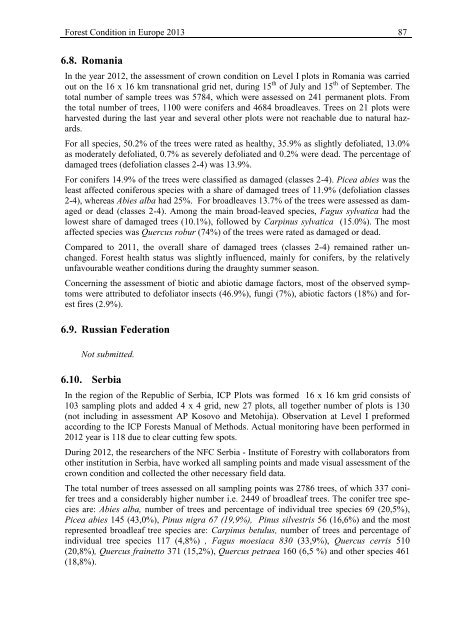Forest Condition in Europe - ICP Forests
Forest Condition in Europe - ICP Forests
Forest Condition in Europe - ICP Forests
Create successful ePaper yourself
Turn your PDF publications into a flip-book with our unique Google optimized e-Paper software.
<strong>Forest</strong> <strong>Condition</strong> <strong>in</strong> <strong>Europe</strong> 2013 87<br />
6.8. Romania<br />
In the year 2012, the assessment of crown condition on Level I plots <strong>in</strong> Romania was carried<br />
out on the 16 x 16 km transnational grid net, dur<strong>in</strong>g 15 th of July and 15 th of September. The<br />
total number of sample trees was 5784, which were assessed on 241 permanent plots. From<br />
the total number of trees, 1100 were conifers and 4684 broadleaves. Trees on 21 plots were<br />
harvested dur<strong>in</strong>g the last year and several other plots were not reachable due to natural hazards.<br />
For all species, 50.2% of the trees were rated as healthy, 35.9% as slightly defoliated, 13.0%<br />
as moderately defoliated, 0.7% as severely defoliated and 0.2% were dead. The percentage of<br />
damaged trees (defoliation classes 2-4) was 13.9%.<br />
For conifers 14.9% of the trees were classified as damaged (classes 2-4). Picea abies was the<br />
least affected coniferous species with a share of damaged trees of 11.9% (defoliation classes<br />
2-4), whereas Abies alba had 25%. For broadleaves 13.7% of the trees were assessed as damaged<br />
or dead (classes 2-4). Among the ma<strong>in</strong> broad-leaved species, Fagus sylvatica had the<br />
lowest share of damaged trees (10.1%), followed by Carp<strong>in</strong>us sylvatica (15.0%). The most<br />
affected species was Quercus robur (74%) of the trees were rated as damaged or dead.<br />
Compared to 2011, the overall share of damaged trees (classes 2-4) rema<strong>in</strong>ed rather unchanged.<br />
<strong>Forest</strong> health status was slightly <strong>in</strong>fluenced, ma<strong>in</strong>ly for conifers, by the relatively<br />
unfavourable weather conditions dur<strong>in</strong>g the draughty summer season.<br />
Concern<strong>in</strong>g the assessment of biotic and abiotic damage factors, most of the observed symptoms<br />
were attributed to defoliator <strong>in</strong>sects (46.9%), fungi (7%), abiotic factors (18%) and forest<br />
fires (2.9%).<br />
6.9. Russian Federation<br />
Not submitted.<br />
6.10. Serbia<br />
In the region of the Republic of Serbia, <strong>ICP</strong> Plots was formed 16 x 16 km grid consists of<br />
103 sampl<strong>in</strong>g plots and added 4 x 4 grid, new 27 plots, all together number of plots is 130<br />
(not <strong>in</strong>clud<strong>in</strong>g <strong>in</strong> assessment AP Kosovo and Metohija). Observation at Level I preformed<br />
accord<strong>in</strong>g to the <strong>ICP</strong> <strong>Forest</strong>s Manual of Methods. Actual monitor<strong>in</strong>g have been performed <strong>in</strong><br />
2012 year is 118 due to clear cutt<strong>in</strong>g few spots.<br />
Dur<strong>in</strong>g 2012, the researchers of the NFC Serbia - Institute of <strong>Forest</strong>ry with collaborators from<br />
other <strong>in</strong>stitution <strong>in</strong> Serbia, have worked all sampl<strong>in</strong>g po<strong>in</strong>ts and made visual assessment of the<br />
crown condition and collected the other necessary field data.<br />
The total number of trees assessed on all sampl<strong>in</strong>g po<strong>in</strong>ts was 2786 trees, of which 337 conifer<br />
trees and a considerably higher number i.e. 2449 of broadleaf trees. The conifer tree species<br />
are: Abies alba, number of trees and percentage of <strong>in</strong>dividual tree species 69 (20,5%),<br />
Picea abies 145 (43,0%), P<strong>in</strong>us nigra 67 (19,9%), P<strong>in</strong>us silvestris 56 (16,6%) and the most<br />
represented broadleaf tree species are: Carp<strong>in</strong>us betulus, number of trees and percentage of<br />
<strong>in</strong>dividual tree species 117 (4,8%) , Fagus moesiaca 830 (33,9%), Quercus cerris 510<br />
(20,8%), Quercus fra<strong>in</strong>etto 371 (15,2%), Quercus petraea 160 (6,5 %) and other species 461<br />
(18,8%).
















